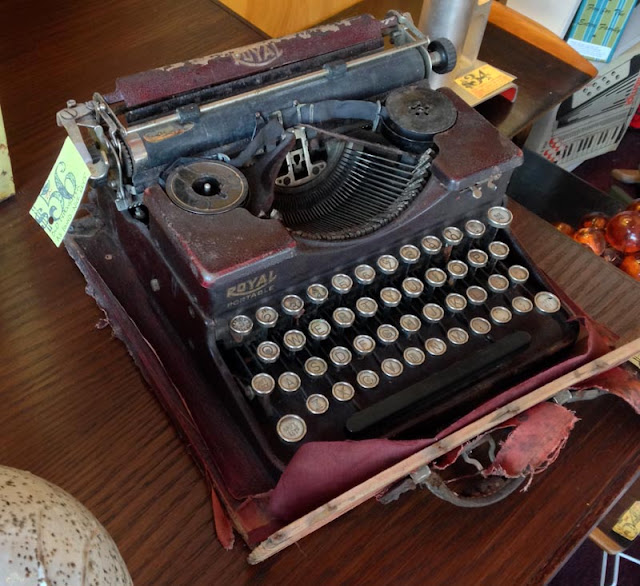Continuing my report from Portland ...
First, a couple more neighborhood theaters I photographed on my bike ride Wednesday morning:
... and a sad, paralyzed Royal seen in an antique shop (no, not Vogue):
But now to the main event: a visit to Oblation Papers and Press with Nick (author of x over it).
The gentleman at the Typing Station was working on some poetry and says he's a regular user.
Two typospherians in action:
Jennie gave us a very interesting impromptu tour of Oblation's papermaking and printing process. This machine (as I understood it) breaks up the hard, thick sheets of recycled cotton fibers.
A vat of cotton and water:
Some of the many molds used to create paper in various shapes:
The paper dries in this room for 24 hours:
This device makes polymer plates for letterpress printing. Their shapes can be designed digitally.
Time to print!
All the printing is done on vintage letterpress equipment.
Using a press requires good rhythm and careful fingers.
Owner Ron Rich started this business 26 years ago, when the now-prosperous Pearl District was just some empty warehouses.
And here's Ben, who restores the typewriters that the shop has been offering for a few years now. They sell about one a week and donate 10% of the proceeds to literacy programs. Ben is an artist trained in metalworking, and says he loves this work.
These bright-red beauties were powder-coated by an outside specialist.
The Hermes Ambassador sports a new platen from J. J. Short.
A letterpress-printed tag on a bright red Corona:
After we purchased some great paper goods, we had pizza and a typewriter show-and-tell. This is the Swiss Calanda that Nick just bought (information on Calandas on Georg Sommeregger's typewriters.ch). At first sight it's a conventional portable, but on a closer look you see that it has several idiosyncratic and clever ways of doing things.
The machine is remarkably flat, with a low-riding carriage.
The segment and type guide are a gorgeous, solid work of art. The entire typebar rests on a wide strip of felt.
The mainspring is located in the center of the typewriter and connects directly to the carriage without the need for any drawband.
Nick also brought his rare Continental 200, ca. 1940.
It strikes me as a machine inspired by the Hermes Baby, but much better built. As on some much bigger typewriters, only the central part of the carriage shifts, for a light and easy experience.
My Junior 58 enjoyed hanging out with the Conti 200.
Next: Ace Typewriter.

































Wow! I am blown away by what I am finding out what is going on with typewriters these days. I am an "OLD" typewriter salesman who is waxing nostalgic. Seems like the mechanical guys have been busy since I left the business in 1982. FYI I started my career at the Cincinnati office of the Underwood Corp. in Aug. of 1960. Olivetti actually owned the company at that time and the name would change over time to Underwood Olivetti, Olivetti Underwood and finally Olivetti USA. I find it interesting that typewriter salesmen are hard to locate these days so I started a FB page: Typewriter Salesperson Page, but anyone with an interest can check it out. I am just trying to locate old friends before we all die off. OH, I want to add this. After nineteen years with Olivetti I went to work for the Memorex Corp, then to Sharp Electronics and finally Olympia International. You will note that of the four multinational companies that I worked for only Sharp remains active today. This did not look good on my resume that I put three of them out of business.
ReplyDeleteThanks for commenting! I'm following you on Facebook. I'm sure you have lots of good stories to share.
DeleteHmmn, I wonder if it's still called "Letterpress" if you're using a polymer offset plate on a flat chase rather than handset metal or wood type & ligatures? I'm curious how they make that work - you can easily image in reverse on the plate (which takes care of the problem of the missing 'offset' blanket) but offset plates work on the principle that oil and water repel each other, and letterpresses don't have a dampening system. Interesting...
ReplyDeleteLove the Hollywood.
ReplyDeleteI would love to visit the paper shop.
Those presses bring back memories -- I learned on some like that and used similar in a print shop.
Oh man! Great to see you and Nick at the public typewriters! Any chance you'll be making it to Seattle? If so, it'd be great to see you.
ReplyDeleteIn fact, I will be in Seattle, but for only one day, and it's going to be taken up with family things. If the stars align, I'll return to promote my book sometime!
DeletePS: I stole your pic of Nick at the Typing Station for the ETCOnline "about" page. Had to photoshop the sign a little closer, fill up some white space. Plus, really had to get the sign in there, ya know. It's important. :D
ReplyDelete